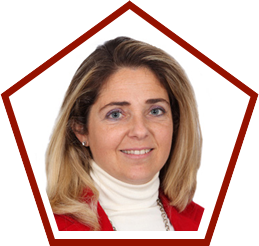
Dr. Elena Orduna Nocito
Biodata
Elena Orduna holds a PhD in English linguistics from Complutense University (UCM) . She is currently the Language Policy Director at the Universidad Francisco de Vitoria, responsible for the implementation of bilingual teaching and EMI methodology at the institution. She is also associate professor at the UCM where she teaches subjects in the area of second language learning and bilingual teaching.
Her research is mainly carried out in the field of english linguistics applied to teaching and second language teaching methology in Higher Education. She has participated in several research proyects such as AICLE (Assessment and evaluation in CLIL), VESPA (Varieties of English for Specific Academic Purposes) and EDICC (European Diploma for Intercultural Competence). Most of her publications are derived from these. Furthermore, she is part of the Executive Committee of ACLES (Asociación Española de Centros de Lenguas de Enseñanza superior).
A bird eye’s view of bilingual education in ehea: a change of paradigm in the spanish university
In the last decade Bilingual Programmes and English as a Medium of Instruction (EMI) in Higher Education has thrived as a teaching aproach throughout Europe. Spanish Tertiary education has experienced a rapid growth in the number of academic content subjects taught in English (SEPIE, 2016), fact which has lead to a complete change of paradigm in language and internationalization policies as well as in academic globalization.
In tertiary institutions the main teaching focus is not so much on Content and Language Learning (CLIL) -as in secondary education-, but rather on EMI due to the bid for “internationalization” which has a double aim: first, allowing national students to experience internationalization at home (Teekens 2013) and, second, integrating national and international students in one same teaching context by using a lingua franca which is not necessarily the mother tongue of lecturers or students. This new approach in tertuary education has generated debate among higher education professionals on the similarities and differences between EMI and CLIL at University (Wilkinson & Zagers 2008, Dalton & Puffer 2011, Gierlinger 2012, Dafouz & Smith 2014).
The transition from teaching through Spanish to English goes beyond linguistic development. It implies major changes in language policy, in the traditional roles of EMI lecturers and English Language teachers, in the threshold language levels set for participants, in teaching approaches, methodologies and pedagogies (planning, timing, didactic materials, assessment, etc.)
There are still some relevant issues to address which currently seem to hinder the gradual implementation of EMI at Spanish universities. First, the English language competence of the university community, second the lack of trainning and instituional support and, finally, the general assumption that EMI lecturers are by no means language teachers. In Spain there is an heterogeneous situation regarding all these issues.However, some general recommendations have been recently set (CRUE 2016, Hallbach & Lázaro 2015).